Easy commentary! “ Decibel (dB) ” which is difficult for ordinary people to understand.
In the world of engineers who are concerned with the audio world, the decibel (dB) display is very often used.
This decibel (dB) display is really very convenient. That’s why engineers love the decibel (dB) display. I often write this article, “increase the volume by 6dB.”
However, it is a decibel (dB) display that is unfamiliar to ordinary people. I don’t study at all in elementary school or junior high school science, and it often appears in consumer electronics catalogs, but it’s like “What’s this?” So, this time, I would like to explain the decibel (dB) display that you often see even if you are not familiar with it.
The decibel display is a relative value. Not an absolute value.
First of all, what dB means is “how many times” or “one part” of something.
For example, “the volume has increased by 6 dB” and “the volume has doubled” have the same meaning.
One common mistake in using the decibel (dB) display is to make it look like an absolute value.
Even if you look at various catalogs, it is easy to think that the specification of the item of XXX is an absolute value because it is written as XXdB, but decibel (dB) is always used to indicate a relative value.
By the way, what about the relative value and the absolute value? . .
“Weight is XXkg” is an absolute value. XXkg is XXkg no matter who you look at and is common throughout the world.
“A’s weight is twice that of B’s” is an expression using relative values. This is because if you do not know the weight of B to be compared, you will not know the weight of A.
“A’s weight is twice as much as B’s” is displayed in decibels (dB), and “A’s weight is 6 dB compared to B’s”.
So, “Volume value is XXdB” is a wrong expression.
With this alone, I do not know what the volume has become XXdB compared to what.
dB must be something to be compared.
(Decibels (dB) in catalogs are often implied by comparison standards, but the comparisons are often not listed anywhere.)
Calculation method of dB
dB is expressed as 20log (X times). (Electricity etc. is expressed by 10log (X), but here it is unified with 20log (X) used for voltage etc.) This is a textbook, so use the scientific calculator attached to Windows OS Let’s do a specific calculation.
How many times to convert to dB
Calculation example)
How many dB is 10 times? In the formula, it is dB = 20log (10 times).
1. Enter 10 times 10 times.
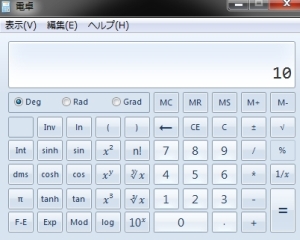
2. Press the log button.
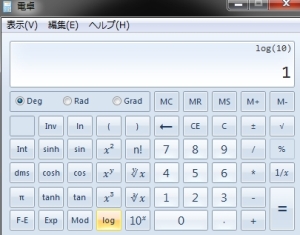
3.Multiply by 20.
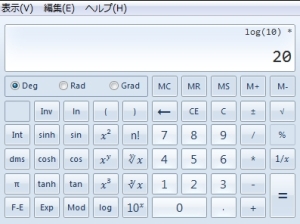
Then the answer will be 20 dB.
If you do the same calculation as above
2 times is about 6 dB
4 times about 12 dB
1000 times 60 dB
10000 times 80 dB
100000 times will be 100 dB.
Since it is troublesome to use a calculator every time, I will place a number -> dB conversion tool (java script) here.
By the way, + 6dB is 2 times, but -6dB means 1/2 (0.5 times).
The dB display expresses “how many times” or “part of what” by preceding the sign.
If you understand so far, you can do more complicated multiple dB display by mental arithmetic.
Question) What is 128 times the dB? Let’s calculate by mental arithmetic.
answer)
128 can be decomposed into 4 × 4 × 4 × 2.
Double is 6dB, quadruple is 12dB,
128 times can be expressed as 12 dB (4 times) +12 dB (4 times) +12 dB (4 times) +6 dB (2 times), and when you add all, you can see that 128 times is 42 dB.
Question) What is 1600 times dB? Let’s calculate by mental arithmetic.
answer)
3200 can be disassembled into 100 × 4 × 4 × 2.
Double is 6dB, quadruple is 12dB, 100x is 40dB,
3200 times can be expressed as 40dB (100 times) + 12dB (4 times) + 12dB (4 times) + 6dB (2 times), and if you add all, you can see that 3200 times is 70dB.
Convert from dB
Let’s convert how many times from dB this time.
First of all, it is when using a scientific calculator. Expression is multiplied by 10 = (dB / 20).
Calculation example)
How many fold is 24 dB?
1. Calculate 24 (dB) ÷ 20.
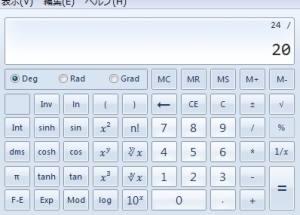
2. Press the ^ X button.
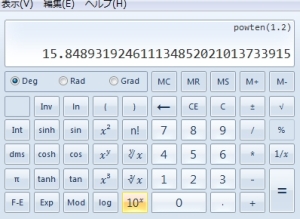
The answer is about 16 times.
Since it is troublesome to use a calculator every time, dB ⇒ here’s how many times a conversion tool (java script) is placed.
It can also be converted easily by mental arithmetic.
Question) How many times is 42 dB?
Answer)
42 (dB) can be broken down into 12 (dB) + 12 (dB) + 12 (dB) +6 (dB).
6 dB is doubled, 12 dB is 4 times
It can be expressed as 4 times × 4 times × 4 times × 2 times, and it can be seen that 42 dB is 128 times.
Why use decibel display
First of all, it is convenient because very large numbers can be represented by a small number of digits.
When expressing 100,000 times, only 3 digits of 100dB are needed.
It is more convenient to express a wide range of numerical values in a graph.

The above graph shows the same contents in dB display and multiple display.
As you can see, when you represent a number with a very large width, the multiple display will cause small values to collapse and become invisible. On that point, it is possible to express up to fine values in dB display.
In the case of sound, the range of numerical values to be handled is very large, and values from 0 (0dB) to 100000 (100dB) are used.
This is an area suitable for handling in dB display.
You can understand the relationship between DA converter and SNR if you understand the dB display
Audio-lovers are talking about USB-DAC, but there are physical limitations to using a system called DA converter. This is a wall that cannot be overcome no matter how hard you design on the circuit side.
Let’s consider the performance limit using the SNR of a DA converter as an example. By the way, SNR (Signal-Noise Ratio) indicates the ratio between the original signal and noise. The higher the SNR, the lower the noise on the signal.
First, let’s look at a 4-bit DAC as an example. All sounds are rounded to 4-bit (16 patterns) data. No matter how expressive and delicate the sound can be expressed in only 16 ways. Sounds that deviate from 16 stages are simply rounded images. Therefore, assuming that the amplitude of the reference sound is 1, the distance (the magnitude of the noise) until the halfway sound that is not on the stairs reaches the stairs is 1/16 (one step of the stairs) from the figure below. You. The noise that moves up the stairs from its original location is called quantization noise.
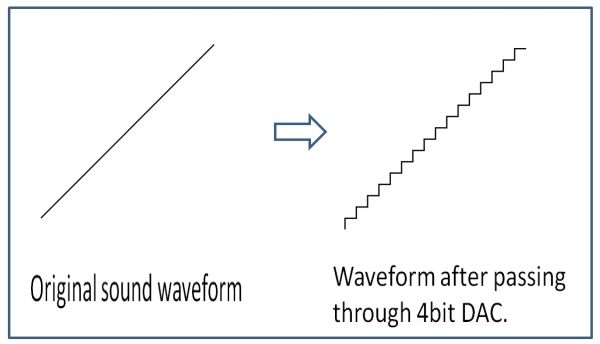
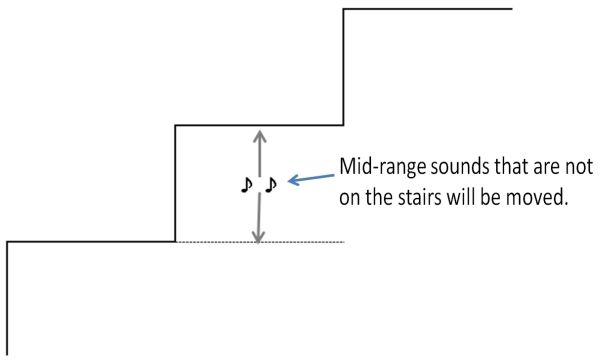
Halfway sounds that are not on the 16 steps are forced to move up or down in the DAC. The distance at the time of this movement becomes noise. For this reason, a DAC having a larger number of bits has a smaller difference of one stair and has less noise. Therefore, the SNR is also good.
Since 1/16 (one stair) becomes noise for the signal, SNR can be calculated as follows.
Signal = 1
Noise = 1/16 (for one stair)
SNR = 1 (1/16) = 16 times
If this 16 times is converted to dB, it will be 24 dB.
* This is a simple way to calculate SNR, and the exact calculation is a bit more complicated.
If you think the same way
SNR = 30dB with 5bit DAC
6bit DAC with SNR = 36dB.
From this, the SNR of an N-bit DAC is
SNR (Nbit) = 6dB x N (bit).
Therefore, when the CD sound quality is 16 bits, the SNR is 6 dB x 16 bits = about 96 dB.
For a 24-bit high-resolution sound source, the SNR is approximately 144 dB.
Using the calculation I learned above, the noise is only 1 / 100,000 for the maximum volume of music because 96dB = about 100000 times for CD. Considering this, the sound of the CD is quite good.
The level of 96dB of this 16bit-DAC. Although this level is still good, when the performance of the DAC becomes 20bit or 24bit, it is difficult to measure just whether the DAC really has the performance. To be honest, it is difficult to measure a high-performance DAC without a fairly chitinized measurement environment.
For example, the measurement value changes only when the wiring in the shielded measurement environment shakes due to the wind. (Coupling capacitance between wiring changes due to the swing of wiring due to acoustic noise, which appears as noise.) That is severe.
In that sense, the human ear is a very high-performance measuring instrument. The person who understands even a slight difference in sound can understand. In addition, a measuring instrument usually evaluates the determined contents such as SNR and THD uniformly with respect to the sound spectrum, but the human ear also evaluates the mental parts such as the comfort of the sound. You. I never evaluate that it is a good sound because SNR and THD are good. It is the best that the sound of a vacuum tube is good. If the sound of Hi-Fi is great, then no one will ever hear the sound of a vacuum tube.
Engineers strive every day to improve the acoustic performance of the designed equipment by 1 dB. In contrast, there are many people who try to evaluate sound with sensibility rather than acoustic performance. Sound is one of the few disciplines that can be seen in both performance and mental aspects. That’s why I find music interesting.


